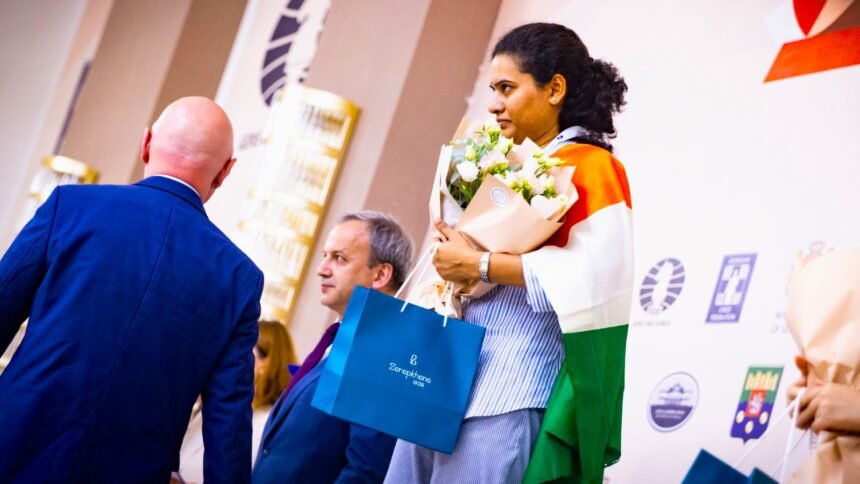Kushager Krishnater calls the week gone by the ‘most draining seven days’ of his career as a chess second. You have a feeling that Koneru Humpy, who at 38 is experiencing a second wind in her pathbreaking career, would agree. Humpy ended second in the FIDE World Cup on Monday, after losing to 19-year-old Divya Deshmukh in a battle of generations at Batumi.
The defeat to Divya came after the first two games in the classical format on Saturday and Sunday ended in draws. Then the first game in the rapid section on Monday ended in a draw as well. Finally, in the second game, there was a breakthrough as Divya managed to clinch victory.
For Humpy and team, finishing second after having come this far left them “gutted”, says Krishnater, who has been a second to Humpy since August 2022. This has included working with the Indian women’s star during her FIDE Women’s Candidates tournament challenge last year. He is an International Master, who has worked with over 10 Grandmasters. This includes super elite grandmasters like Arjun Erigaisi and Vidit Gujrathi, besides Humpy. A FIDE Master at 16, he was an IM by the age of 18.
Krishnater says that the World Cup is the “most difficult format” for Humpy, since, at 38, it means playing for one month at her peak level, which she managed until the final tiebreak game. He details the intense work that the team did after both classical games ended in draws.
“After the match against Alexandra Kosteniuk, the intensity of our work is something that we have never reached so far in our working relationship. For example, we worked till 11 in the night on Sunday (during the final against Divya). And on Monday morning, we started at 8 am, and went on till 11.30 am, which was just one hour before the game. She gave it all, despite like one month of consistency and her being in a stage of her career where she has played for so many years. It is a physically taxing job, playing nearly one month at a FIDE World Cup,” says Krishater. “I can easily say that since the time we have been working together, this has been the most draining work — physically draining work — for both of us, especially for Humpy.”
While he admits he did not discuss her workout regime, he does say: “To do this for 24 days, I don’t think it’s easy for anyone. I’m sure she was working out diligently before she came. That’s why even during the quarter-finals, she was very fresh.”
It’s that freshness, that’s allowed her to keep battles going and try to squeeze water out of stone, like in the second classical game against China’s Lei Tingjie, where Krishnater thought after a point that there was “no venom left” in the pieces. But Humpy continued playing and soon, she was one move away from victory.
Story continues below this ad
On the board, all the work that is happening behind the scenes is bearing fruit.
“The fact that Humpy’s style is constantly evolving and she is showing a familiarity with a lot of the latest trends tells me that she is working very hard, that she is still motivated to work and update herself on things. Most importantly, she courageously enters those battles with opponents no matter what their age or training was,” five-time world champion Viswanathan Anand told The Indian Express.
The crazy hours Krishnater details are something that are par for the course for young teenage players like Divya or Gukesh, who have the energy to work for hours on chess before striding into a battle and then grind it out for five-six hours more. And then doing it all over again the next day. For Humpy, this was also a challenge because over the last few years, she has managed to find a balance between her family life and her professional pursuit — which is rare in Indian chess.
As Krishnater points out, that ever since Humpy reached the quarters, she entered the zone of focussing primarily on her chess.
Story continues below this ad
“After Humpy reached the quarter-finals, it has been so hectic. I can easily say that the past week has been like the most draining job for me. Having worked with all kinds of players, this has been the most difficult job. And then to think that Humpy is somebody who is 38, and still willing to give it all,” he says.
The FIDE Women’s World Cup is the second-most prestigious event in chess, behind the Women’s World Championship. But unlike the Women’s World Championship, which features up to 12 one-on-one battles between the same two players, the World Cup is a seven-round tournament where Humpy had to play six opponents of different skillsets in two one-on-one classical games (and games in faster time controls after that if needed).
Besides the work behind the scenes, Anand also credits a changed mindset for Humpy’s recent results: she won the World Rapid Championship in December last year for the second time in her career. Anand calls it Humpy’s “willingness to learn and to experiment” rather than sticking with things that have worked well for her.
“Her confidence, the fact that she has done well in the World Rapid Championship last year also suggests that she is comfortable with all kinds of formats. Maybe the main thing is an open mind. She is willing to take on any format, and doesn’t tell herself that I’m good in this (format). The main force driving this for Humpy is that she feels good about herself,” says Anand before drawing a comparison with Hikaru Nakamura: “Maybe she now competes without feeling a lot of pressure and she just thinks, ‘let me try this and enjoy myself’. That attitude comes across very well, maybe in a way similar to Hikaru.”







